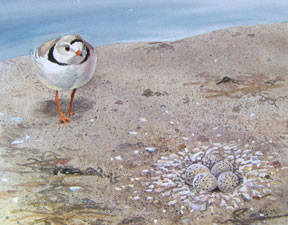|
Offseasons
It is the offseasons I love the most; almost any naturalist does. The beach in early spring, swept clean by winter storms, only the barest hint of green at the base of the Ammophila clumps. A piping plover, like the pale ghost of a semipalmated plover, runs, stops, freezes, pipes its plaintive note. It has just arrived on a March warm front, though the day holds no warmth. Here it will stay, and dig its shallow cup in the sand, and lay its precious chocolate-flecked khaki eggs among the shell bits. On the clean spring beach, there is hope and life beginning.

Visit the same beach in July, if you dare, and thread your way past the rows of parked cars and through the blare of radios and scent of cocoa butter, weave your way through the prone human bodies strewn about the sand, and try to believe it is the same beach you tramped alone in March. Look for the piping plovers, but they are gone. Were they able to bring off their young, tiny balls of thistledown, before the crowds descended? You marvel that piping plovers still exist in this scenario. Yes, it is the offseasons I love most.
Every spring, along about late March, a silent alarm sounds in my heart for the arriving plovers. While working for The Nature Conservancy, I created the flagship program to protect them along the Connecticut coastline for three seasons, from 1983-1986; to put up string fencing and educational signs, to fence off the vital beach nesting areas used by plovers and least terns. I'd sniff the air rushing by in the first big warm front of March, and know they had arrived. I'd drive down to the coast and hit all eight or ten nesting areas, and there they would be, twinkling over the low dunes and down by the lapping wavelets of Long Island Sound. Even as I tried to predict where they might settle, and planned the massive effort of protecting their nesting areas, they ran energetically over the sand, the embodiment of undimmed hope.
Certainly, one would have to be an optimist to lay one's precious eggs on the sand of a busy Connecticut beach, where the day patrol of seminude bodies and romping dogs gives way to a night shift of skunks, rats, cats, and red foxes. For those three seasons, I felt a great weight of responsibility to protect them, and I walked the flesh off my bones, lugging heavy signposts to the remote beaches where they chose to nest.
Mingling with fishermen, sunbathers, jet skiers, the curious and the simply nasty, I spread a strange gospel of tolerance and caring to people who had no idea such birds existed, even as they ran past their feet and flew over their heads. "How could there be birds nesting here?" I was asked. "There arenít any trees!" I relieved one well-meaning family of its brood of least tern chicks, carefully gathered up into a picnic basket to be taken home, but I never was able to catch the people who gathered and ate the tern and plover eggs every spring at a little beach below Bridgeport. It was a time best looked back upon from the remove of having done it, and then moved on.
And yet, March comes, and this little bell goes off, and I catch a certain scent on even in the Ohio wind, so very far from the coastline, and I remember those afternoons of heavy gray skies and leaden waves and tiny pale birds, when almost all I had to worry about was plovers and terns. Conservation efforts such as the one I created often run on the bright, hot fuel of the young and caring. More often than not, it is women who take up the cause of these fragile beach nesters, who are moved enough by their plight to act. Some might label it a misdirected maternal instinct; whatever it is, it is a potent force for good, and the women conservationists I came to know were like a pride of lionesses, willing to stop at nothing to protect their charges.
At the time, blinded by the need to act, I couldn't understand why I had so much trouble scraping up even a handful of volunteers who'd help, when that need was so obvious; now, as three-year-old Phoebe pads into the room and climbs onto my lap, and I hear four-month-old Liam awakening too early from his afternoon nap, I understand.
We become entangled in the gentle mesh of family life, in the need to rise from a warm bed four and five times during a night to fill a tummy or smooth a brow, to be home for nurturing of our own young. The young of plovers and terns must fend for themselves. And I say a silent prayer of thanks for the next student, fresh from wildlife management courses, who takes on the job of trying to protect them. It is a continuously revolving door, for only a very few people last more than a year or two at such a strenuous and occasionally disheartening job.
Offseasons; I am in one now, when I must stay close to home, anchored by naptimes, mealtimes. Cabin fever prowls around my mind, rubbing its lean sides on my psyche. I find myself thinking of small pale birds and porcelain eggs among the shell bits, and wondering who is taking care of them now.
|
|
|

